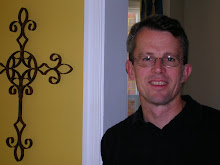Cave-Dwelling Christians -- FPC sermon excerpt
When I was first ordained, I was called to serve an old church: The First United Church of Christ in Milford, Connecticut. Founded in 1639, this church existed for 137 years before the founding of the United States of America.
But the Milford church is just a baby compared to a church recently discovered in a cave in Northern Jordan. Dating back to the first century, this underground chapel probably served as both a place of worship and a home. Archaeologists believe that about 70 persecuted Christians used the cave after fleeing Jerusalem. These early Christians had to live and practice their faith in secrecy until the Romans embraced Christianity several hundred years later.
“We found beautiful things,” said one of the archaeologists to the BBC (June 10, 2008). “Pottery shards and lamps … a very old inscription … coins … and crosses made from iron.” If this turns out to be an authentic church, it will be the oldest ever found, by about 200 years.
The very first believers were Cave-Dwelling Christians.
Now we can certainly understand why the members of this first-century church practiced their faith in secrecy. The Romans were actively persecuting Christians, and their army completely flattened Jerusalem in the year 70. So the church had to go underground if it wanted to survive.
But what is our excuse today? When I look around, I see many of us behaving like Cave-Dwelling Christians, even though we have no fear of persecution in the United States. We come inside the walls of this Sanctuary to worship, and rarely have congregational activities outside the church building. We talk about our faith in church school classes and small group meetings, but feel awkward sharing what we believe with the world.
It almost as though we are practicing our faith in secret.
In contrast to the way we behave today, Jesus took his ministry out into the world, healing the sick, casting out demons, and preaching throughout the region of Galilee. In the first chapter of the Gospel of Mark, Jesus leaves the synagogue in Capernaum and enters the house of Simon and Andrew. He goes outside the walls of the sanctuary, and visits Simon’s mother-in-law, in bed with a fever. He takes her by the hand and lifts her up, and the fever leaves her. She is instantly healed, and then she begins to serve them (Mark 1:29-31).
But the Milford church is just a baby compared to a church recently discovered in a cave in Northern Jordan. Dating back to the first century, this underground chapel probably served as both a place of worship and a home. Archaeologists believe that about 70 persecuted Christians used the cave after fleeing Jerusalem. These early Christians had to live and practice their faith in secrecy until the Romans embraced Christianity several hundred years later.
“We found beautiful things,” said one of the archaeologists to the BBC (June 10, 2008). “Pottery shards and lamps … a very old inscription … coins … and crosses made from iron.” If this turns out to be an authentic church, it will be the oldest ever found, by about 200 years.
The very first believers were Cave-Dwelling Christians.
Now we can certainly understand why the members of this first-century church practiced their faith in secrecy. The Romans were actively persecuting Christians, and their army completely flattened Jerusalem in the year 70. So the church had to go underground if it wanted to survive.
But what is our excuse today? When I look around, I see many of us behaving like Cave-Dwelling Christians, even though we have no fear of persecution in the United States. We come inside the walls of this Sanctuary to worship, and rarely have congregational activities outside the church building. We talk about our faith in church school classes and small group meetings, but feel awkward sharing what we believe with the world.
It almost as though we are practicing our faith in secret.
In contrast to the way we behave today, Jesus took his ministry out into the world, healing the sick, casting out demons, and preaching throughout the region of Galilee. In the first chapter of the Gospel of Mark, Jesus leaves the synagogue in Capernaum and enters the house of Simon and Andrew. He goes outside the walls of the sanctuary, and visits Simon’s mother-in-law, in bed with a fever. He takes her by the hand and lifts her up, and the fever leaves her. She is instantly healed, and then she begins to serve them (Mark 1:29-31).


0 Comments:
Post a Comment
<< Home